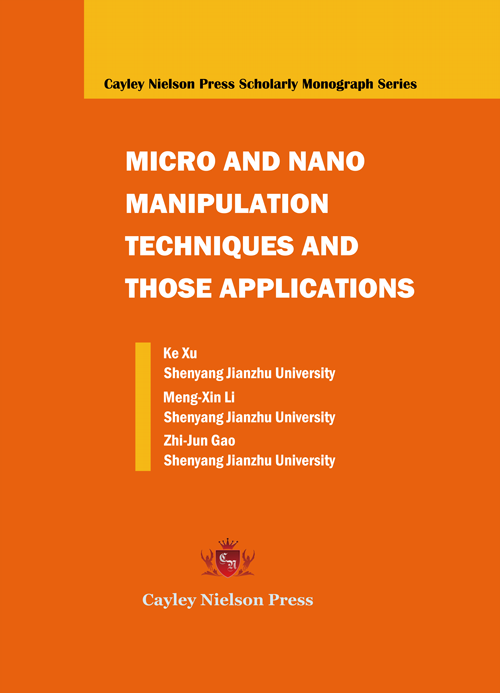
MICRO AND NANO MANIPULATION TECHNIQUES AND THOSE APPLICATIONS

Ke Xu
Shenyang Jianzhu University
Meng-Xin Li
Shenyang Jianzhu University
Zhi-Jun Gao
Shenyang Jianzhu University
Copyright © 2017 by Cayley Nielson Press, Inc.
ISBN: 978-0-692-84995-8
Cayley Nielson Press Scholarly Monograph Series Book Code No.: 129-5-9
US$150.00
Preface
Since Atomic Force Microscope (AFM) was invented by G. Binnig in 1986, it has rapidly promoted the development of nano science and technology research. One of the research’s ultimate aims is to fabricate device or system on nanometer scale, or even on atom & molecule scale, and the necessities to realize this aim is the method, technology and instrument for controllably accurate nanomanipulation. Explore the fundamentals of device physics, synthesis, and design of molecular processing platforms and molecular integrated circuits within three-dimensional topologies, organizations, and architectures as well as bottom-up fabrication utilizing quantum effects and unique phenomena........
Contents
Preface............................................................................................................................................. I
1 Modeling And Stable Manipulation Strategy Based On Robotic Nano-Hand..... 1
1.1 Introduction........................................................................................................................... 1
1.2 Nano-Hand Strategy For Manipulation......................................................................... 4
1.3 Basic Theory Analysis......................................................................................................... 6
1.4 Modeling And Scheduling............................................................................................... 10
1.4.1 Kinematics Model And Manipulation Of Nanoparticle..................................... 10
1.4.2 Kinematics Model And Manipulation Strategy Of Nano-Rod......................... 17
1.5 Implementation And Experimental Results........................................................... 24
1.5.1 System Configuration................................................................................................... 24
1.5.2 Manipulation Experiments Of Nanoparticle And Nanorod............................ 26
1.6 Brief Summary................................................................................................................... 29
2 Scanning Ion Conductance Microscopy For Non- Invasive Nanoscale Imaging 31
2.1 Fast Imaging For Scanning Ion Conductance Microscopy................................... 31
2.1.1 Introduction..................................................................................................................... 31
2.1.2 Fast Imaging Method.................................................................................................... 34
2.1.3 Experimental Setup...................................................................................................... 35
2.1.4 Experimental Results................................................................................................... 39
2.2 Amplitude Modulation Mode Of Scanning Ion-Conductance Microscopy..... 42
2.2.1 Introduction..................................................................................................................... 42
2.2.2 Introduction To Am-Sicm............................................................................................ 44
2.2.3 Core Units Of Am-Sicm................................................................................................. 45
2.2.4 Units Experiment Verification And Discussions................................................. 48
2.3 In-Phase Amplitude Modulation Mode Of Scanning Ion Conductance Microscopy 52
2.3.1 Introduction..................................................................................................................... 52
2.3.2 Introduction To Ipam-Sicm........................................................................................ 53
2.3.3 Capacitance Compensation In Ipam-Sicm............................................................. 62
2.3.4 Units Experiment Verification And Discussions................................................. 66
2.4 Brief Summary................................................................................................................... 74
3 Manipulation Of Micro And Nano Particles And Cells By Optically-Induced Dielectrophoresis 75
3.1 Rapid Assembly Of Gold Nanoparticle-Based Microstruc- Tures..................... 75
3.1.1 Introduction..................................................................................................................... 75
3.1.2 Experimental Setup...................................................................................................... 79
3.1.3 Rapid Assembly Of Aunps-Based Microstructures........................................... 82
3.1.4 Discussion......................................................................................................................... 85
3.1.5 Rapid Assembly Of Aunps Into Microelectrodes................................................ 93
3.2 Distinctive Translational And Self-Rotational Motion Of Lymphoma Cells In An Optically-Induced Non-Rotational Ac Electric Field......................................................................................................................... 97
3.2.1 Introduction..................................................................................................................... 97
3.2.2 Materials And Methods............................................................................................. 100
3.2.3 Results............................................................................................................................. 107
3.2.4 Disscussion.................................................................................................................... 116
3.4 Brief Summary................................................................................................................. 120
4 Method To Fabricate Nanowire-Based Devices By Dielectrophoresis............ 122
4.1 Fabrication Of A Single Cuo Nanowire-Based Gas Sensor Working At Room Temperature 122
4.1.1 Introduction.................................................................................................................. 122
4.1.2materials And Method................................................................................................ 124
4.1.3 Experiment.................................................................................................................... 128
4.2 Single Cu Nanowire Assembled By Microdroplet Dielectrophoresis On Ultrahigh Tensible Microelectrodes 136
4.2.1 Introduction.................................................................................................................. 136
4.2.2materials And Method................................................................................................ 138
4.2.3 Simulation Of Single Cu Nanowire Dielectrophoresis Assembly............... 142
4.2.4 Experiment Of Single Cu Nanowire Assembly.................................................. 144
4.3 Brief Summary................................................................................................................. 147
5 Micro-Scale Manipulation By Light-Driven Micro-Robotics................................ 148
5.1 Controlled Micro-Gripper Fabricated From Light-Induced Deformation Smart Material 148
5.1.1 Introduction.................................................................................................................. 148
5.1.2 Materials And Methods............................................................................................. 150
5.1.3 Experimental Results................................................................................................ 154
5.1.4 Analysis And Discussion........................................................................................... 162
5.2 Miniaturized Soft Robotwith Complex Movement Actuated And Controlled By Remote Light Signals 166
5.2.1 Introduction.................................................................................................................. 166
5.2.2 Light-Driving Material............................................................................................... 168
5.2.3 Swimming Robot With Gripper.............................................................................. 169
5.2.4 Results And Discussion............................................................................................. 171
5.3 Brief Summary................................................................................................................. 176
6 Fabrication And Measurement Technologies At Nanoscale For Organic Solar Cell And Biomechanics 177
6.1 Facile Hydrothermal Preparation Of Zno/Co3o4 Heterogeneous Nanostructures And Its Photovoltaic Effect 177
6.1.1 Introduction.................................................................................................................. 177
6.1.2 Experiments And Characterization Methods.................................................... 178
6.1.3 Results And Discussions........................................................................................... 182
6.2 Multiscale Modeling And Simulation For Optimizing Polymer Bulk Heterojunction Solar Cells 188
6.2.1 Introduction.................................................................................................................. 188
6.2.2 Multiscale Modeling And Simulation................................................................... 191
6.2.3 Optimization Via Multiscale Simulation............................................................. 207
6.3 Performance Improvement Of Organic Solar Cells With The Introduction Of Branched Zinc Oxide Nanorods 210
6.3.1 Introduction.................................................................................................................. 210
6.3.2 Experiments And Methods:..................................................................................... 212
6.3.3 Results And Discussion............................................................................................. 216
6.4 Finite Element Simulation Of Stress Relaxation Process In Living Cells.... 221
6.4.1 Introduction.................................................................................................................. 221
6.4.2 Experiments Methods............................................................................................... 222
6.4.3 Finite Element Simulation Of Stress Relaxation.............................................. 224
6.4.4 Results And Discussion............................................................................................. 226
6.5 Zinc Oxide/Copper Oxide Heterogeneous Nanowire Preparation And Application In Uv Sensor 232
6.5.1 Introduction.................................................................................................................. 232
6.5.2 Experiment And Characterization Method........................................................ 233
6.5.3 Results And Discussions........................................................................................... 235
6.6 A Novel Approach For Preparation Of Cuo Nanostructures On Conductive Substrate 240
6.6.1 Introduction.................................................................................................................. 240
6.6.2 Experiment Methods And Characterization...................................................... 242
6.6.3 Results And Discussion............................................................................................. 244
6.7 Brief Summary................................................................................................................. 249
7. Optical Fiber Sensors Based On D-Shaped Structure........................................... 250
7.1 Introduction...................................................................................................................... 250
7.2 Configurations And Working Principles Of D-Shaped Optical Fibers.......... 252
7.2.1 D-Shaped Optical Fibers Configurations............................................................. 252
7.2.2 Working Principle Of D-Shaped Optical Fiber Sensors.................................. 254
7.3 Sensing Applications Based On D-Shaped Optical Fiber.................................. 255
7.3.1 Electric Field Sensors................................................................................................. 255
7.3.2 Temperature Sensors................................................................................................ 258
7.3.3 Stress Sensors............................................................................................................... 260
7.3.4 Magnetic Field Sensors.............................................................................................. 262
7.3.5 Biosensors...................................................................................................................... 264
7.4 Brief Summary................................................................................................................. 268
References................................................................................................................................ 270
Readership
This book should be useful for students, scientists, engineers and professionals working in the areas of optoelectronic packaging, photonic devices, semiconductor technology, materials science, polymer science, electrical and electronics engineering. This book could be used for one semester course on adhesives for photonics packaging designed for both undergraduate and graduate engineering students.
